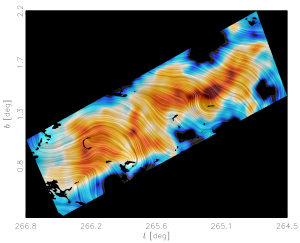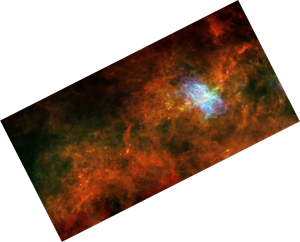BLAST-TNG Observations of Nearby Regions of Star Formation
BLAST-TNG will map magnetic fields in some of closest sites of star formation in our galaxy. For these nearby star-forming clouds we will be able to make extremely detailed maps, with sub-arcminute resolution and tens of thousands of measurements of magnetic field orientation per cloud. This allows BLAST-TNG to resolve magnetic fields on the scales of dense filaments, and in some case the dense cores where individual stellar systems may be forming.
Figure 1:
A BLASTPol magnetic field map of the Vela C star-forming region made with BLAST-TNG’s predecessor BLASTPol (Fissel et al., 2016) from a 500 micron polarization map with a resolution of 2.5’. The background image shows the light emitted by the dust grains, which shows the structure of the cloud. The “streaks” overlaid on top of the image show the orientation of the magnetic field inferred from BLASTPol data. BLAST-TNG will be able to map all of the nearby clouds (d<1000 pc) visible from Antarctica with five times better resolution than BLASTPol.
Figure 2:
Herschel Far-IR composite image of the Vela C molecular cloud (Red=250μm, Green= 160μm and Blue=70μm) from the HOBYS Survey (Hill et al 2011). This image shows the structure of Vela C in high detail (15’’ resolution), showing the many filaments, ridges, and compact cores where individual stars may be forming. BLAST-TNG will be able to map the magnetic field for this star forming region and many others at almost the same resolution as Herschel (25’’).






